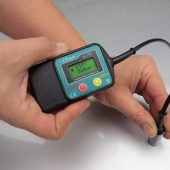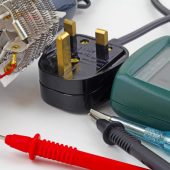An SWR meter measures the standing wave ratio between an antenna and feed line, allowing you to adjust the antenna to the best length for signal performance and to prevent damage to your radio.
Standing waves are present in many kinds of situations. There are standing waves of water, standing waves in air and you can even make standing waves using a slinky.
Standing waves can also occur in RF transmission between the transmitter and the antenna. They happen when the impedance of the feed line and the antenna do not match, causing some of the electrical energy sent to the antenna to be reflected back.
This energy coincides with output from the transmitter going the opposite way, resulting in standing waves.
SWR or standing wave ratio is the ratio of the highest voltage to the lowest voltage on the feed line, which is why an SWR meter is sometimes called a VSWR meter, with the V standing for voltage. A high SWR indicate high voltage, which can damage the feed line, transmitter and other components.
High SWR also reduces power output from the transmitter, which will lower transmission performance.
When you are setting up an antenna, it is important to get the SWR as close as possible to 1:1. It means all the radio’s power is being transmitted as radio signals. A ratio lower than 1.5:1 across all channels is great. Use an SWR meter to get your system’s SWR to this range.
An SWR meter has two connections, one for the transmitter and the other for the feedline going to the antenna. You can then measure the SWR for different frequencies.
In this buying guide, we review the best SWR meters and give you tips for choosing the best one for your needs.
Key Considerations When Buying an SWR Meter
A. Frequency Range
It is essential that you get an SWR meter that is compatible with the frequency range of your radio system.
A mismatch between the frequency range of your radio and that of the meter will reduce sensitivity and lead to inaccurate measurement.
If, like most people, you are buying an SWR meter to tune your CB radio, you’ll need a meter that covers the 26-27 MHz band (the legal frequency band for CB radios in both the UK and US).
If you are tuning a higher-frequency system such as a UHF or VHF radio, look for an SWR meter that accommodates the high frequency.
B. Power
Another aspect that you need to match between your system and the SWR meter is power. Different SWR meters are rated to handle varying power outputs.
If you have a CB radio, you don’t need to worry since the max output is only 4 watts (that is if the radio has not been modified to, illegally, increase power output). Most SWR meters can handle at least 100W of power with pricier models having a range of up to 500W.
Some SWR meters come with a knob that allows you to adjust the power range depending on the output of your radio. Make sure you select a power level that’s as close as possible but higher than your transmitter’s output.
C. Measurements
In addition to SWR, check if the meter offers any additional measurements. Most SWR meters will also measure the output power and some display the frequency as well.
D. Digital vs. Analogue
A surprising number of SWR meters are analogue, at a time when most devices are digital. Analogue meters are just as accurate as digital ones, though it can be a bit difficult to tell the exact number where the needle is resting.
E. Backlit Display
We highly recommend getting an SWR meter with a backlit display. It’ll allow you to tune your radio’s antenna even in the dark.
F. Portability
If you are buying an SWR meter for tuning your CB radio, look for one that’s small and easy to carry around. That’s because most people use CB radios on the go, usually in a vehicle.
If you want to tune a walkie-talkie, you’ll need an even smaller, pocket-sized SWR meter that you can carry in your pocket or bag.
If you are tuning a stationary radio, either at home or work, you can afford to get a bigger meter since you don’t need to carry it around.
Note: Before you buy an SWR meter, check if your radio already has a built-in SWR meter. If it does, you can use it to tune your antenna. However, you may still want to invest in an external SWR meter as it’s more accurate.
Best SWR Meters: Top 5 Reviews
1. Mcbazel Surecom SW-102 Digital VHF/UHF 125-525Mhz Antenna Power & SWR Meter Review

If you prefer the straightforward display of a digital SWR meter, we recommend the Mcbazel Surecom SW-102. Instead of a needle, the display shows a figure for the VSWR.
In addition to the main ratio, the display also indicates the frequency of transmission (using a built-in frequency counter) as well as the power.
The Surecom SW-102 has a frequency range of 100 to 520 MHz, meaning you cannot use it with a CB radio. It’s ideal for VHF and UHF radios.
The maximum power is 120W.
The display is backlit, but several users say it’s a bit too small. If you have eyesight problems, you may have trouble reading numbers on the screen.
The Surecom SW-102 runs on an internal rechargeable lithium polymer battery. You can monitor battery level using the battery indicator on the display.
What we like about it:
- Ideal for high-frequency radios.
- Backlit display.
- Indicates power and frequency in addition to SWR.
- Compact and highly portable.
2. Maas RX – 40 MHz N-Buchse 140–525 SWR Meter Review

If you prefer a good old needle and scale SWR meter, the Maas RX is a good choice. With a frequency range of 140 to 525 MHz, it is meant for use with VHF and UHF radios, including ham radios and marine radios.
The Maas RX measure SWR as well as forward and reflected power.
The power range when measuring forward transmission is 15-150w, while the reflected power range is 5-50w.
The best thing about the Maas RX is that it displays all three parameters simultaneously. While most analogue SWR meters can only show reflected and forward power one at a time, you can see all three at a glance when using the Maas RX meter.
Another unique feature is that it doesn’t require calibration, making it easier and faster to use.
Because the multi-parameter display and the fact that you don’t need to calibrate it, the Maas RX SWR meter has a very simple interface; just a single button. There are no buttons for CAL or SET nor are there button for witching between reflected and forward modes.
This makes the Maas RX utterly simple to operate.
The only downside is the backlight. The Maas RX does have display lighting, but you have to connect the meter to a 12V DC outlet to use it.
What we like about it:
- Compact and light – easy to carry around.
- Simultaneous power and SWR measurements.
- No calibration required.
- Easy to use.
3. Meuse RS-1000 SWR Meter 1.8-1300 MHz Review

If you need to measure very high or very low frequencies, get the Meuse RS-1000 SWR meter. It can measure the SWR of radios with frequencies between 1.8 and 1,300 MHz, making it one of the most versatile SWR meters among our picks.
The wide frequency range makes the Meuse RS-1000 ideal for CB radios as well as VHF and UHF radio.
The power limit is also higher than with other SWR meters. You can set the power at 5W (perfect for CB radios), 20W, 200W and 400W.
It’s no surprise that the Meuse RS-1000 is our most expensive pick.
It’s also not surprising that it’s bigger and heavier than other SWR meters. Keep this in mind if you want a meter you can use on the go. We recommend it for use in a vehicle or building.
If you need a compact on-the-go SWR meter, check out our next pick below.
The analogue display is large and backlit. You’ll have no trouble reading measurements. Note that you’ll need to adjust the frequency range depending on the frequency of your transmission. You can set it at 1.8-160 MHz or 430-1300 MHz.
What we like about it:
- Wide frequency and power range – idea for use with different kinds of radios.
- Large and backlit display.
- Durable metal construction.
4. Mcbazel SW-33 Mark II 100 W 125~525Mhz Power and SWR Meter Review

The Mcbazel SW-33 Mark II is the best choice for anyone who wants a pocket-sized SWR meter. The SW-33 Mark II is designed specifically for walkie-talkies, but you can also use it for VHF and UHF radios.
The frequency range of the SW-33 Mark II is 125 to 525 MHz and the max power is 100W.
The digital display (no scales and needles) shows two things: the VSWR and forward power.
Accessories include adapters, a USB charging cable for the internal battery and a 50-ohm dummy load.
What we like about it:
- Pocket-size – easy portability.
- Digital display – easier and faster to read compared to an analogue screen.
- Incudes adapters and dummy load.
- Low price.
5. Hima UV RF PS100 Antenna Analyzer Review

The Hima UV RF PS100 is the most advanced SWR meter among our picks. The digital meter has a large colourful display that shows multiple measurements including SWR, impedance (resistance), reactance, S11 (return loss) and other detailed measurements.
The Hima UV RF PS100 is designed to meet the needs of professional. Even the frequency range is extra-wide to accommodate different kinds of systems with frequencies as low as 137.5 MHz and as high as 2.7 GHz.
Despite the many functions and wide power and frequency range, the PS100 SWR meter is surprisingly compact and light. It weighs just 299g, making it perfect for professionals that need to keep an SWR meter handy.
The PS100 runs on a rechargeable battery.
What we like about it:
- Multiple measurements.
- Large backlit display.
- Small and light – easy to carry around.



Choosing an SWR metre that works with the type of radio you are using is quite important. Not all SWR metres work with every radio. You can discover several that are intended only for CB radios, for example. Others, meanwhile, only function with amateur radios. Some are compatible with GMRS radio as well.